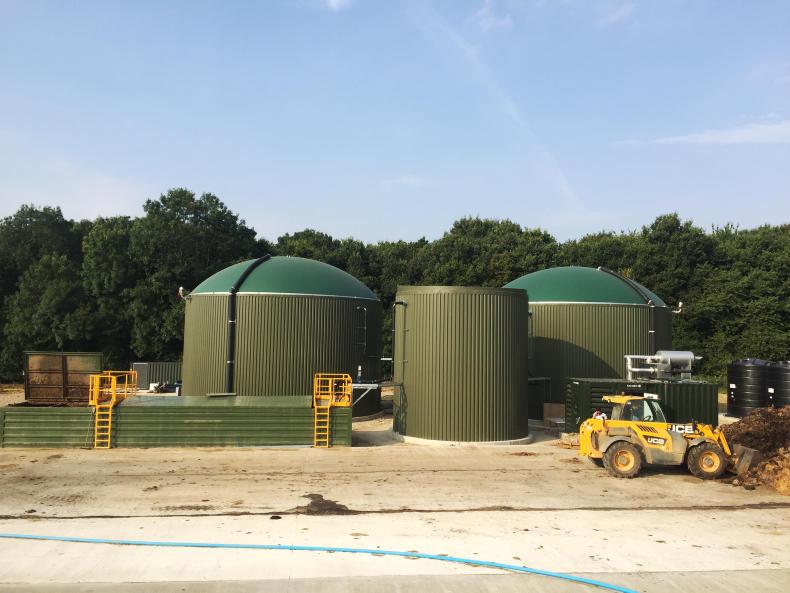Under the 2009 Renewable Energy Directive, Ireland is committed to producing from renewable sources at least 16% of all energy consumed by 2020. The Government aims to meet this directive by generating 40% renewable electricity, 12% renewable heat and 10% from the renewable transport sector. From working with Harp Renewables, I took the time to examine the potential use and viability of anaerobic digestion (AD) as a source of renewable energy amid increasing demands on the agricultural sector to lower its energy consumption and emissions.
The process
Establishing an AD plant is complex with many factors such as land availability, grid connection, planning and available incentives to account for. AD plants produce heat and electricity, but there are a number of criteria which affect the price paid to the owner.
In the UK both electricity and heat can be utilised and incentivised. Depending on the date of grid connection, the AD plant will be administered a fixed, index-linked electricity tariff which will remain for 20 years. As more pre-accreditation occurs for AD plants, this fixed tariff is devalued. This is known as degression. This is dictated by the extent (in MgW/hr) of surplus supply which connects to the national grid per annum. A large oversupply generally leads to a 20% tariff decrease, while a slight oversupply is indicative of a 10% tariff drop.
In the UK, Wales, Scotland and Northern Ireland a government-funded renewable heat incentive (RHI) is available. Currently RHI does not exist in Ireland, immediately reducing the viability of AD for Irish farmers. However, strict criteria and eligibility for this incentive is implemented. The heat generated must be used for a purpose such as drying grain or drying digestate for further biomass use. It is probable that a tillage farmer, who chooses to grow maize instead of sowing wheat or reseeding grass, for the sole purpose of feeding an AD plant, may not qualify for RHI as that process is not deemed "renewable".
The definition of renewable
Renewable energy, in almost all of its forms, in not viable without incentives. Solar panels and wind turbines are incentivised. Take the UK as an example. PV panels offer 20-40 pence per Kw/hr to people who chose to install them. As uptake for solar panels increased, like the electricity tariff for AD, the price dropped. However, with huge demand remaining, the price of manufacturing was lowered, which maintained the viability of installing a PV panel. This manufacturing cost trend also occurred on wind farms were economies of scale came into play. The challenge for AD is that capital costs remain high. Concrete, large tanks, specialised technology, etc, all require considerable capital which creates a much larger risk for a potential customer in comparison to a PV panel on his/her roof. If other sources of renewable energy are incentivised, why should AD not receive the same government-funded boost to maintain viability?
The ethical issues
A model AD plant has been established by Lincolnshire county council in the UK. The council manage almost 4,000 miles of rural roadside verges. The grass cuttings gathered from these verges, as well as food waste collected from the council, form the feedstock ration for the AD plant. Principally, this AD plant is renewable, utilising marginal land in tandem with waste to generate electricity and heat.
However, in principle, many established AD plants are not "renewable". Fields are allocated to grow energy crops such as maize, fodder beet and grass silage for the specific purpose of feeding an AD plant. These crops are blended with farm yard manure or slurry. It should be noted that by utilising slurry, sewage, food waste, etc, in AD plants, problems like pollution are lessened and a valuable commodity generated. However, the moral and ethical issue of sowing, cultivating and harvesting crops by burning fossil fuels to create renewable energy can deter many from establishing such projects on ethical grounds.
The future
Regarding the viability of Irish AD plants, some development must be sought to implement RHI in the near future. Without this, a tariff of 17-20c per Kw/hr is the minimum limit at which AD is viable. AD is a relatively untapped market in Ireland, and if sustainable incentives become available, could offer an additional income option to many farm families.
In terms of AD in the UK, viability is ensured at 5-6p/Kw/hr alongside RHI, again this value being the minimum limit. However, in the UK Brexit has had a seismic effect on the renewable sector and created widespread uncertainty. The Department of Energy and Climate Change (DECC) has been decommissioned. At the current rate of degression, and without a government department in place, AD pre-accreditation could become unviable by March 2017 according to Bill Chubb, managing director of Green Gas UK Ltd. The uncertainty surrounding the electricity tariff and the difficulty involved with RHI eligibility mean AD establishments must seek additional income in the form of gate fees for food waste, sewage, effluent, slurry, etc. According to Bill, unless there is a massive policy change, the short-term outlook for AD plants in the agricultural sector is not promising, while food waste plants are better positioned.
My time at Harp Renewables has been thoroughly enjoyable, delving into many facets of the renewable energy sector. By working as part of the Harp Renewables team I’ve gained valuable knowledge into the processes and potential of anaerobic digestion. I wish the company every success in the future, and could not have asked for a more welcoming workplace, friendly and caring workers and a fantastic final stint to my professional work experience.
Read more from James Meade: Exploring renewable energy at Harp Renewables







 This is a subscriber-only article
This is a subscriber-only article










SHARING OPTIONS: